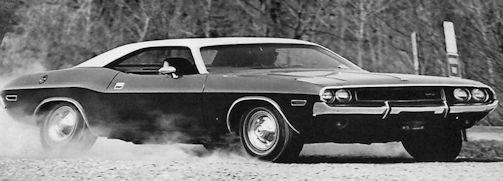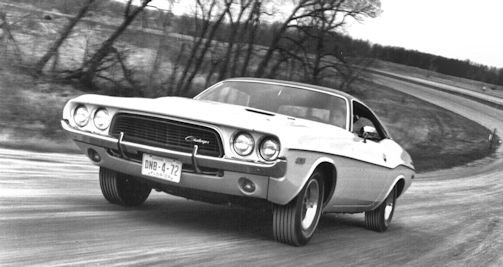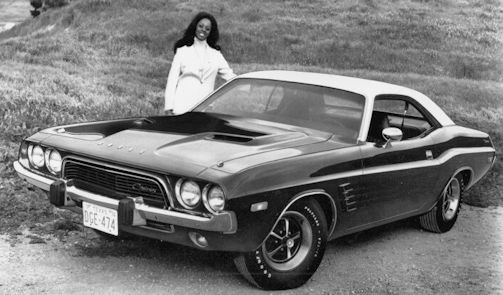Dodge Challenger First generation
 | |
Production period: | 1969 to 1974 |
Body versions : | Coupe , convertible |
Engines: | Gasoline engines : 3.2-7.2 liters |
Length: | 4859 mm |
Width: | 1983 mm |
Height: | 1293 mm |
Wheelbase : | 2794 mm |
Curb weight : | 1436-1725 kg |
The first Dodge Challenger was introduced in the model year 1970 and belonged to the named after the first Ford Mustang vehicle family of pony cars (long hood, short deck) compact sports coupe or convertible.
The Challenger was largely identical to the third generation Plymouth Barracuda ; The bodywork was slightly modified and the wheelbase extended by 5 cm. The design came from Carl Cameron, who had already designed the Dodge Charger from 1966. Although the Challenger with 83,032 units sold in the first year of production was a good reception in the market, but it appeared at a time when the decline of the Pony Cars was already emerging. After only five years, the Challenger was discontinued with the end of the model year 1974 without replacement. A total of 188,611 first-generation vehicles were sold.
The Challenger was available as Hardtop Coupé without B-pillar and in 1970/71 as Cabriolet. The top model of the series was the Challenger R / T, which was available only in 1970 as a convertible. The base model as well as the R / T coupe could be ordered in an SE version with leather seats, vinyl roofand a smaller rear window. From 1972, the R / T variant was dropped, instead, a rally called version came into the program. At the same time, the most powerful engines and many performance extras were no longer available. Only in 1970 was the Challenger T / A available, a homologation model for the Trans-Am series equipped with a special 5.6 l V8 (340 cui ), three double carburetors and a fiberglass engine hood with a large air scoop . The tubes of the sport exhaust flowed laterally in front of the rear wheels ( sidepipes ). Also standard were anti-roll bars front and rear, different width tires on the front and rear (Polyglas GT, rear G60-15, in some exceptions 275-55x15 or 285-60x15, front E60-15) and rear spoiler. Optionally, a front spoiler and a rear jalousie (J68 - Window Louvers) could be ordered. In model year 1972 accounted for all high-performance engines; strongest engine was since then an eight-cylinder, which was then discontinued in early 1974 then.

The body remained unchanged over the entire life of the Challenger, twice the grille was modified. The models 1970/71 had a retired barbecue, which received a central pier in 1971. From 1972, the grill was at a height with the headlights. The models of the years 1972 to 1974 can be distinguished by the increasing from year to year bumper horns. The tail lights ranged in the model year 1970 over the entire width of the car. In 1971, the reversing lights were arranged on the left and right side of the license plate. As of 1972, the Challenger had four individual taillight lenses.
Quarter Miles
Listing of the best times achieved over the quarter mile at a standstill:
- 340: 14.8 seconds, final speed 155 km / h
- 340 T / A: 13.99 seconds, top speed 157 km / h
- 383: 15.1 seconds, final speed 150 km / h
- 440 Magnum R / T: 13.9 seconds, final speed 163 km / h
- 440 Six-Pack: 13.6 seconds, final speed 167 km / h
- 426 Hemi: 13.2 seconds, final speed 169 km / h

Rating
Technical
-
Engines
1970
engine code
Displacement
(in 3 / cm 3 )design type
mixture preparation
Braking power (SAE gross)
(bhp / kW)B ***
198/3245
R6
Single carburetor
101 / 75,3
C
225/3687
145 / 108,1
G
318/5211
V8
Two-barrel carburetor
230 / 171.5
H
340/5572
Four-barrel carburetor
275 / 205,1
J **
Three double carburetors
290 / 216,3
L
383/6276
Two-barrel carburetor
L
Four-barrel carburetor
330 / 246,1
N
335 / 249.8
R *
426/6981
Two quad carburetors
425 / 316.9
U *
440/7210
Four-barrel carburetor
375 / 279.6
V *
Three double carburetors
390 / 290.8
- * Only for Challenger R / T
- ** Only for Challenger T / A
- *** Only for Challenger Deputy



